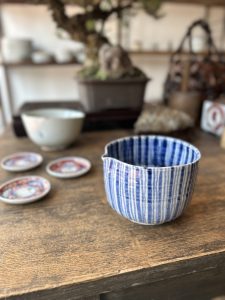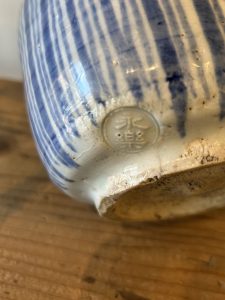1世紀以上経っても、渦巻きです(愛知県名古屋市千種区姫池通 骨董買取 古美術風光舎)
2025.07.26
暑中お見舞い申し上げます。
今年の梅雨は思いのほか短かかったので、いつも以上に夏が長く感じます。まだ7月…。

あっという間に夏至からひと月経って、暦の上では大暑となりました。一年のうちで最も暑さの厳しい時節です。蝉も盛んに鳴いて夏真っ盛り。キョウチクトウの花が揺れ、ホウセンカ、ヒャクニチソウ、オシロイバナ、夏休みの思い出とともにあった花々も咲き誇っています。
それから青い空に入道雲。気がつけば、大暑は夏の最後の二十四節気。大暑の15日間がすぎるともう立秋なのかと思うと、なんだか妙に慌ててしまいます。
とは言え、来週の予想気温が軒並み38℃以上なのを見ると、立秋の風情など感じられず、げんなりしてしまいます。そういえば、このところの酷暑で、あの耳元でブーンとまとわりつく蚊があまり気にならない気がするのですが。
それもそのはず。「蚊といえば夏!」というイメージですが、このところは真夏の気温が高すぎて活動できないのだそう。もはや「蚊」は秋の季語になってしまうのかもしれません。
暑い時期に出てくる蚊ですが、気温が高いほど活発に飛び回るわけではなく、気温が25〜30℃になると活発に活動し始めます。この気温だとわずか10日ほどで卵から成虫になります。ところが、30℃を超え暑くなると徐々に動きが鈍くなり、35℃以上の猛暑日は、植木の葉裏などの日陰に身を潜めているのだそう。
実際、35℃以上になると刺されにくかったという実験結果も。ただ、日が落ちて気温が下がればまた活発になるので、暑すぎる夏だからと無防備にというわけにはいきません。それにしても、気温が30℃を超えると動きが鈍くなるのですから、蚊も夏バテしていたのですね。
蚊といえば「蚊取り線香」。日本人にとっては夏の風物詩です。
人類と蚊との戦いの歴史をひもといてみると、2000年以上も昔、エジプト・クレオパトラの時代に「蚊帳」を使っていたそうです。日本でのルーツは、平安時代に使われていた「蚊遣り火(かやりび)」にあると言われています。当時は、よもぎの葉やカヤの木、杉や松の青葉を火鉢で燃やし、煙を炊いて燻すやり方で蚊を追い払っていました。ただ、当時は今の蚊取り線香のように化学的な殺虫効果はなく、ただでさえ暑い時期にモクモクと燻されて、相当な煙たさだったのではなかろうかと思われます。
やがて、明治中期になると大日本除虫菊株式会社が初めて、殺虫効果のある蚊取り線香を開発しました。
蚊取り線香の原料である「除虫菊」はキク科の多年草で、和名は「シロバナムシヨケギク」と言います。原産国はセルビア共和国で、この花は古くから殺虫効果があると言われています。
日本に初めて防虫菊が伝わったのは1886年。
アメリカから大日本除虫菊株式会社の創業者へ種子が贈られ、線香に防虫菊を練り込んだ「蚊取り線香」が誕生しました。その後、和歌山県を中心として国内で除虫菊の栽培に成功し、人々に広まっていきました。
そんな蚊取り線香ですが、最初は今のような「渦巻き型」ではなく「棒状」のものが製造されていました。しかし棒状の蚊取り線香は、仏壇線香のように細かったため、約40分くらいで燃えつきてしまうのと、運んでいる間に折れやすいという欠点が…。
そこで、もっと長時間使えて効力を高めるものとして、明治28年(1895年)「金鳥」が、とぐろを巻いた蛇をヒントに、渦巻型を発売しました。渦巻はまっすぐにすると約75cmあり、人の寝ている時間に合わせて約7時間燃え続けるようになっています。発売当時この渦巻は、2巻ずつすべて、人の手によって巻かれていたのだそうですよ。
最近では、香りの成分が練り込んであったり、太巻や細巻になっていたり、ペットにも使える天然成分が入っていたり、手軽なスプレー型など色々な蚊取り線香が登場しています。
でも、やっぱり懐かしい記憶をほんのり浮かび上がらせてくれる気がする蚊取り線香が好きです。
ではでは、また。(スタッフT)

I would like to extend my best wishes for the hot summer season.
The rainy season this year was unexpectedly short, so summer seems longer than usual. It is still July.
In no time at all, a month has passed since the summer solstice, and according to the calendar, it has become the hottest month of the year. It is the hottest time of the year. The cicadas are singing actively and summer is in full swing. Oleander flowers are swaying in the air, and flowers such as balsam fir, Japanese honeysuckle, and white flowers are in full bloom, which brings back memories of summer vacations.
And then there are the blue sky and the iridocumulus clouds. I realized that “Daigatsu” is the last 24 days of summer. I feel strangely panicky thinking that it will already be Risshu (the first day of autumn) after the 15 days of Great Summer Heat.
However, when I see that the forecast temperature for the next week is 38 degrees Celsius or higher across the board, I feel depressed because I don’t feel the atmosphere of Risshaku. Come to think of it, the mosquitoes buzzing around my ears don’t seem to bother me so much in this extremely hot summer.
That’s because they don’t seem to be bothering me as much. Mosquitoes are associated with summer! but the temperature in midsummer is too high for mosquitoes to be active these days. Mosquitoes” may become a seasonal word for fall.
Although mosquitoes appear during the hot season, they do not fly around as actively as they do when the temperature is high; they become active when the temperature reaches 25 to 30℃. At these temperatures, the eggs turn into adults in just 10 days or so. However, when the temperature rises above 30°C (86°F), the mosquito gradually slows down, and on extremely hot days (above 35°C), it hides in the shade behind the leaves of trees and shrubs.
In fact, experiments have shown that insects were less likely to sting when the temperature was above 35°C. However, they become active again when the sun goes down and the temperature drops, so you cannot be unprotected just because it is too hot in summer. But mosquitoes must be suffering from summer fatigue because they slow down when the temperature rises above 30°C. Speaking of mosquitoes, we should not forget about mosquito repellents.
Speaking of mosquitoes, “mosquito coils. For Japanese people, it is a summer tradition.
If we look back into the history of mankind’s battle with mosquitoes, we find that “mosquito nets” were used more than 2,000 years ago, in the time of Cleopatra of Egypt. Its roots in Japan can be traced back to the “mosquito fire” used in the Heian period (794-1185). At that time, mosquitoes were driven away by burning mugwort leaves, kaya wood, and green leaves of cedar and pine trees in a brazier to cook the smoke and smother it. However, at that time, mosquito coils did not have the chemical insecticidal effect of today’s mosquito coils, and the smoke from these coils must have been quite smoky even during the hot season.
In the mid-Meiji period, Dainippon Jochiku Co., Ltd. developed the first mosquito coil with an insecticidal effect.
Pyrethrum, the raw material of mosquito coils, is a perennial herb of the Asteraceae family, and its Japanese name is “Shirobanamushiyokegiku. Its country of origin is the Republic of Serbia, and its flowers have long been said to have insecticidal properties.
Insect repellent chrysanthemums were first introduced to Japan in 1886.
Seeds were sent from the U.S. to the founder of Dainippon Pyrethrum, and “mosquito coils” were created by kneading insect repellent chrysanthemums into incense sticks. Later, pyrethrum was successfully cultivated in Japan, mainly in Wakayama Prefecture, and spread to other people.
At first, mosquito coils were manufactured in the form of sticks, not spirals as we know them today. However, stick-shaped mosquito coils, like Buddhist altar coils, were too thin and burned out in about 40 minutes, and also broke easily during transportation.
In response, in 1895, “Kintori,” taking a hint from a coiled snake, launched a whirlpool type as a product that could be used for a longer period of time and with greater efficacy. The whirlpool is about 75 cm long when straightened and keeps burning for about 7 hours, according to the time a person sleeps. At the time of its launch, these whirlpools were all wound by hand, two rolls at a time.
Recently, various types of mosquito coils have appeared on the market, such as those with fragrant ingredients kneaded into the coils, in thick or thin rolls, containing natural ingredients that can be used for pets, and in convenient spray-type coils.
However, I still prefer mosquito coils that bring up nostalgic memories.
See you soon. (Staff T)
*******************
ご実家の整理やお片付けなどをされている方のご相談などが多くございます。
お片付けなどくれぐれもご無理のないようになさってくださいませ。
風光舎では古美術品や骨董品の他にも絵画や宝石、趣味のお品など様々なジャンルのものを買受しております。
お片付けをされていて、こういうものでもいいのかしらと迷われているものでも、どうぞお気軽にご相談下さいませ。
また風光舎は、出張買取も強化しております。ご近所はもちろん、愛知県内、岐阜県、三重県その他の県へも出張いたします。
まずは、お電話お待ちしております。
愛知県名古屋市千種区姫池通
骨董 買取【古美術 風光舎 名古屋店】
TEL052(734)8444
10:00-18:00 OPEN

